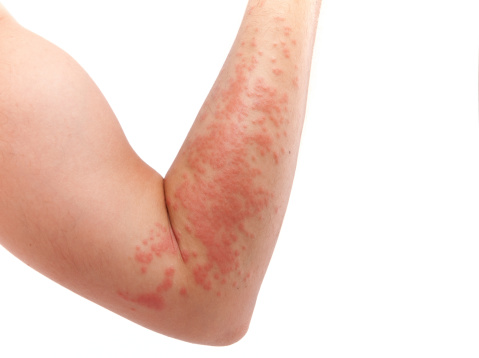News - Wed, 01/03/2018 - 14:51
Does your child have itchy, red skin? It may be Atopic Dermatitis
Last update 01/11/2018 - 10:14

It is not a contagious disease. It usually begins in childhood but adults are also concerned.
The causes of A.D. are not exactly known. They combine a predisposition to A.D. often inherited and immune, environmental factors as well as the disturbance of good intestinal and skin bacteria, this can become more serious through abuse of antibiotics.
A.D. is often associated with asthma and hay fever.
It touches 10 to 20% of children in Europe and in the United States. The percentage of affected children has been rapidly increasing in developing countries as well, more so in cities than in rural areas.
A.D. is often mixed up with Allergic Contact Eczema; which is an allergic reaction against a substance or product that manifests as eczema. In some circumstances a child can have both of them at the same time.
How do you recognize Atopic Dermatitis?
Your child’s skin is:
- DRY rough and scaly
- It is very ITCHY
- It is INFLAMED
The skin shows redness, very small blisters, weeping, cracking and crusting.
The skin areas affected can be the cheeks, the arm folds, the back of knees, cracks behind the ears, but can really be anywhere on the body.
It affects predominantly infants and young children, usually beginning before the age of 6 months, and occasionally adults.
- Atopic Dermatitis is a long lasting disease. During some periods symptoms may worsen followed by periods when the skin improves, sometimes healing completely, a state that is called remission.
- 50% of A.D. symptoms disappear around the age of 5 in your child, although the skin may always seem dry and remain easily irritated.
How to treat your child?
- First of all you will have to avoid triggers that worsen A.D.
It can be aggravated by:
- Irritants such as detergents, antiseptics, hot baths, harsh soaps.
- Synthetic fibers, wool
- Temperature:
- In summer sweating causes itching
- In winter cold weather dries the skin
- Super infection:
- Bacteria, viruses, fungi (impetigo, herpes…)
- Allergens:
- Seasonal pollen, dust mites animal dander and mold.
- Stress
- Hormones
- Most important you will have to take care of your child’s skin.
Daily Protect and hydrate the skin:
- Give lukewarm baths with lye free soap
- Moisture the skin immediately following the bath with emollient cream
- Keep finger nails short
- Choose soft breathable cotton clothing
- Breastfeed your infant and introduce other foods progressively.
- Keep the child cool
- Recently the use of probiotics (lactobacillus…) as can be found in probiotic yoghurts has proven to be very efficient to avoid flare ups.
- In case of a flare up your doctor may prescribe some of the following:
- Antihistaminic medicine, if itching is very severe.
- Corticosteroid creams or ointments.
- Tacrolimus or Picrolimus non-steroid topical ointments referred to as immune modulators
- Phototherapy using ultraviolet A or B light for adults only.
In case of severe A.D. and after specialist advice only the following drugs can be prescribed
- Immunosuppressive drugs (cyclosporine)
- Biologic drugs as dupilumab
In conclusion, Atopic Dermatitis is known as a long term disease. Although it is a very uncomfortable disease for your child an it can be successfully managed with the cooperation of the child, the family and the treating doctor.
And don’t forget a simple thing like daily moisturizing and avoiding triggers can help your child get through Atopic Dermatitis comfortably.
Dr. Nelly Gerard is a French specialist in Dermatology &Venereal Diseases who has recently joined the French Hospital Hanoi to bring her expertise to our customers and colleagues.
For further information, please contact us at: (84-24) 3577 1100 or send us an inquiry here



